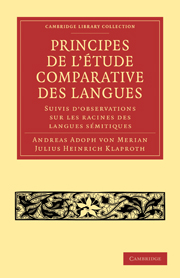
-
Select format
-
- Publisher:
- Cambridge University Press
- Publication date:
- October 2010
- January 2010
- ISBN:
- 9780511695285
- 9781108006859
- Dimensions:
- Weight & Pages:
- Dimensions:
- (216 x 140 mm)
- Weight & Pages:
- 0.33kg, 252 Pages
You may already have access via personal or institutional login
Book description
This wide-ranging comparative analysis of languages was one of the earliest products of the nineteenth century's burgeoning interest in philology. Its author was the French diplomat Baron de Merian, a contemporary of Wihelm von Humboldt and precursor of Franz Bopp and August Schleicher (also published in this series). Published shortly after Merian's death in 1828, this meticulous study is the result of twelve years of painstaking work. Merian concisely maps out the languages of the world, and attempts to trace all major dialects back to a common root. He ably demonstrates his competence as a philologist, illustrating his argument through extensive charts and tables, and does not shy away from topics such as Basque and Native American vocabulary which still pose problems for linguists today. Though many of Merian's theories have since been disproved, his pioneering work deserves its place in the history of linguistics.
Contents
Metrics
Full text views
Full text views help Loading metrics...
Loading metrics...
* Views captured on Cambridge Core between #date#. This data will be updated every 24 hours.
Usage data cannot currently be displayed.
Accessibility standard: Unknown
Why this information is here
This section outlines the accessibility features of this content - including support for screen readers, full keyboard navigation and high-contrast display options. This may not be relevant for you.
Accessibility Information
Accessibility compliance for the PDF of this book is currently unknown and may be updated in the future.

